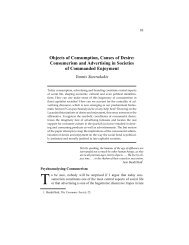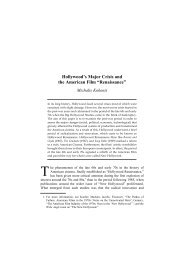19 International Symposium on Theoretical and Applied Linguistics ...
19 International Symposium on Theoretical and Applied Linguistics ...
19 International Symposium on Theoretical and Applied Linguistics ...
Create successful ePaper yourself
Turn your PDF publications into a flip-book with our unique Google optimized e-Paper software.
G E N E R A L S E S S I O N<br />
Asher <strong>and</strong> Lascarides (2003) am<strong>on</strong>g others attempt to formalize the interacti<strong>on</strong> between discourse<br />
<strong>and</strong> lexical semantic knowledge. For instance, in (1), the denotati<strong>on</strong> of the causing part of the verb<br />
σπάζω (=break) in the first sentence is elaborated <strong>on</strong> by two verbs that denote two different events,<br />
namely σπρώχνω (=push) <strong>and</strong> πέφτω (=fall). In (1), there is no c<strong>on</strong>juncti<strong>on</strong> <strong>and</strong> therefore, there is no<br />
indicati<strong>on</strong> as to how the two sentences comprise a coherent discourse.<br />
(1) Ο Γιάννης έσπασε το ποτήρι. Έσπρωξε το τραπέζι και αυτό έπεσε.<br />
John broke the glass. He pushed the table <strong>and</strong> (then) it fell.<br />
Two apparently irrelevant events in the sec<strong>on</strong>d sentence, the pushing <strong>and</strong> the falling, are able to pick<br />
out the causing part of the verbal denotati<strong>on</strong>. The questi<strong>on</strong> that emerges then is: what is the status of<br />
the causing sub-event? Should we assume that a sub-event is decomposed into other events<br />
arbitrarily? Is there any criteri<strong>on</strong> for identifying parts of the breaking with the pushing of the table <strong>and</strong><br />
the falling of the glass events? The paradox that appears here is that <strong>on</strong>e event can be identified with<br />
arbitrarily many parts <strong>and</strong> that it st<strong>and</strong>s in straightforward c<strong>on</strong>tradicti<strong>on</strong> of its own status; namely that it<br />
is a term with <strong>on</strong>tological integrity.<br />
I suggest that events should not be rejected altogether under the light of these questi<strong>on</strong>s, but that<br />
summati<strong>on</strong> of their parts with the same <strong>on</strong>tological status is not the right way to proceed. It has been<br />
noticed throughout the literature (a.o. Davids<strong>on</strong> <str<strong>on</strong>g>19</str<strong>on</strong>g>67, Kamp <strong>and</strong> Reyle <str<strong>on</strong>g>19</str<strong>on</strong>g>93, Higginbotham 2000) that<br />
there is no theory that can provide clear identity <strong>and</strong> identificati<strong>on</strong> criteria for saying whether the sum<br />
of the two events, of the pushing of the table <strong>and</strong> falling of the glass can be identified with the causing<br />
of the breaking. A way out of the paradoxical situati<strong>on</strong> comes when <strong>on</strong>e recognizes the fact that the<br />
verb denotes an event, but that its parts are not of the same status. Since there is no clear-cut<br />
criteri<strong>on</strong> for identifying parts of an event, I assume that the parts of an event are c<strong>on</strong>ceptual<br />
c<strong>on</strong>struals. Their main purpose is to pick parts of the spatiotemporal c<strong>on</strong>tinuum that can be thought of<br />
as causing the breaking in a specific c<strong>on</strong>text. For this analysis I will use the discourse-sensitive<br />
strategy of Asher <strong>and</strong> Lascarides (2003) in order to dem<strong>on</strong>strate the advantages of using discourse<br />
entities or labels of informati<strong>on</strong> implied by a verb <strong>and</strong> that are available for discourse inference.<br />
References<br />
Alsina, A. <str<strong>on</strong>g>19</str<strong>on</strong>g>96. The Role of Argument Structure in Grammar. CSLI Publicati<strong>on</strong>s.<br />
Asher, N. <str<strong>on</strong>g>19</str<strong>on</strong>g>93. Reference to Abstract Objects in Discourse. Kluwer Academic Publishers.<br />
Asher, N. <strong>and</strong> Lascarides, A. 2003. Logics of C<strong>on</strong>versati<strong>on</strong>. Cambridge University Press.<br />
Davids<strong>on</strong>, D. <str<strong>on</strong>g>19</str<strong>on</strong>g>67. The Logical Form of Acti<strong>on</strong> Sentences. In N. Rescher (ed.), The Logic of Decisi<strong>on</strong> <strong>and</strong> Acti<strong>on</strong>.<br />
University of Pittsburgh Press, reprinted in Davids<strong>on</strong>, 2001a.<br />
Hale, K. <strong>and</strong> Keyser, J. <str<strong>on</strong>g>19</str<strong>on</strong>g>93. On argument structure <strong>and</strong> the lexical representati<strong>on</strong> of syntactic relati<strong>on</strong>s. In K.<br />
Hale <strong>and</strong> J. Keyser (eds), The View from Building 20, MIT Press.<br />
Higginbotham, J. 2000. On events in linguistic semantics. In J. Higginbotham, F. Pianesi <strong>and</strong> A. C. Varzi (eds),<br />
Speaking of Events. Oxford University Press.<br />
Kamp, H. <strong>and</strong> Reyle, U. <str<strong>on</strong>g>19</str<strong>on</strong>g>93. From Discourse to Logic: Introducti<strong>on</strong> to Model-theoretic Semantics of Natural<br />
Language, Formal Logic <strong>and</strong> Discourse Representati<strong>on</strong> Theory. Kluwer Academic Publishers.<br />
Kratzer, A. <str<strong>on</strong>g>19</str<strong>on</strong>g>96. Severing the External Argument from its Verb. In J. Rooryck <strong>and</strong> L. Zaring (eds.), Phrase<br />
Structure <strong>and</strong> the Lexic<strong>on</strong>. Dordrecht: Kluwer.<br />
Levin, B. <strong>and</strong> M. Rappaport Hovav <str<strong>on</strong>g>19</str<strong>on</strong>g>99. Two Structures for Compositi<strong>on</strong>ally Derived Events. Proceedings of<br />
SALT 9. Cornell <strong>Linguistics</strong> Circle Publicati<strong>on</strong>s.<br />
Levin, B. <strong>and</strong> M. Rappaport Hovav 2005. Argument Realizati<strong>on</strong>. Cambridge University Press.<br />
Pustejovsky, J. <str<strong>on</strong>g>19</str<strong>on</strong>g>95. The Generative Lexic<strong>on</strong>. Cambridge: MIT Press.<br />
Ramch<strong>and</strong>, G. 2008. Verb Meaning <strong>and</strong> The Lexic<strong>on</strong>: A First Phase Syntax. Cambridge University Press.<br />
Impact of a high-stakes English exam<br />
<strong>on</strong> teachers <strong>and</strong> students' percepti<strong>on</strong>s, attitudes <strong>and</strong> practices<br />
Dina Tsagari<br />
Hellenic Open University<br />
tsagaric@otenet.gr<br />
High-stakes language examinati<strong>on</strong>s have important c<strong>on</strong>sequences <strong>on</strong> the curriculum, teaching <strong>and</strong><br />
learning. They are often used as instruments that can leverage educati<strong>on</strong>al change. The First<br />
Certificate in English (FCE by Cambridge ESOL) is a well-known language exam that is administered<br />
widely in private language instituti<strong>on</strong>s in Greece. Its designers are interested in strengthening the<br />
relati<strong>on</strong>ship between teaching <strong>and</strong> testing by attempting to bring FCE in line with recent developments<br />
in the fields of linguistics <strong>and</strong> applied linguistics so as to have a positive influence <strong>on</strong> what happens in<br />
the classroom.<br />
This paper explores the relati<strong>on</strong>ship between the intenti<strong>on</strong>s of the FCE exam designers <strong>and</strong> the<br />
teachers <strong>and</strong> students who are preparing for the exam. It presents findings of teachers <strong>and</strong> students’<br />
<str<strong>on</strong>g>19</str<strong>on</strong>g> th ISTAL 55






